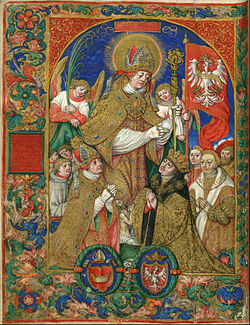
The cult of Saint Stanisław the martyr began immediately upon his death. In 1245 his relics were translated (i.e., moved) to Kraków's Wawel Cathedral. In the early 13th century, Bishop Iwo Odrowąż initiated preparations for Stanisław's canonization and ordered Wincenty of Kielce to write the martyr's vita. On September 17, 1253, at Assisi, Stanisław was canonized by Pope Innocent IV.
Pope Pius V did not include the Saint's feast day in the Tridentine Calendar for use throughout the Roman Catholic Church. Subsequently Pope Clement VIII inserted it, setting it for May 7, but Kraków observes it on May 8, a supposed date of the Saint's death, having done so since May 8, 1254, when it was attended by many Polish bishops and princes. In 1969, the Roman Catholic Church moved the feast to April 11, considered to be the date of his death in 1079.[3]
Silver sarcophagus of St. Stanislaus in the Wawel Cathedral. As the first native Polish saint, Stanisław is the patron of Poland and Kraków, and of some Polish dioceses. He shares the patronage of Poland with Saint Adalbert of Prague, Florian, and Our Lady the Queen of Poland.
Wawel Cathedral, which holds the Saint's relics, became a principal national shrine. Almost all the Polish kings beginning with Władysław I the Elbow-high were crowned while kneeling before Stanisław's sarcophagus, which stands in the middle of the cathedral. In the 17th century, King Władysław IV Vasa commissioned an ornate silver coffin to hold the Saint's relics. It was destroyed by Swedish troops during The Deluge, but was replaced with a new one ca. 1670.
Saint Stanisław's veneration has had great patriotic importance. In the period of Poland's feudal fragmentation, it was believed that Poland would one day reintegrate as had the members of Saint Stanisław's body. Half a millennium after Poland had indeed reintegrated, and while yet another dismemberment of the polity was underway in the Partitions of the Polish-Lithuanian Commonwealth, the framers of the Polish Constitution of May 3, 1791, would dedicate this progressive political document to Saint Stanisław Szczepanowski, whose feast day fell close to the date of the Constitution's adoption.
Each year on May 8, a procession, led by the Bishop of Kraków, goes out from Wawel to the Church on the Rock. The procession, once a local event, was popularized in the 20th century by Polish Primate Stefan Wyszyński and Archbishop of Kraków, Karol Wojtyła. Wojtyla, as Pope John Paul II, called Saint Stanisław the patron saint of moral order and wanted his first papal return to Poland to occur in April, 1979 in observance of the 900th anniversary to the day of his martyrdom, but the Communist rulers of that time blocked this, causing the visit to be delayed until June of that year.
Roman Catholic churches belonging to Polish communities outside Poland are often dedicated to Saint Stanisław.
In iconography, Saint Stanisław is usually depicted as a bishop holding a sword, the instrument of his martyrdom, and sometimes with Piotr rising from the dead at his feet.
Pope Pius V did not include the Saint's feast day in the Tridentine Calendar for use throughout the Roman Catholic Church. Subsequently Pope Clement VIII inserted it, setting it for May 7, but Kraków observes it on May 8, a supposed date of the Saint's death, having done so since May 8, 1254, when it was attended by many Polish bishops and princes. In 1969, the Roman Catholic Church moved the feast to April 11, considered to be the date of his death in 1079.[3]
Silver sarcophagus of St. Stanislaus in the Wawel Cathedral. As the first native Polish saint, Stanisław is the patron of Poland and Kraków, and of some Polish dioceses. He shares the patronage of Poland with Saint Adalbert of Prague, Florian, and Our Lady the Queen of Poland.
Wawel Cathedral, which holds the Saint's relics, became a principal national shrine. Almost all the Polish kings beginning with Władysław I the Elbow-high were crowned while kneeling before Stanisław's sarcophagus, which stands in the middle of the cathedral. In the 17th century, King Władysław IV Vasa commissioned an ornate silver coffin to hold the Saint's relics. It was destroyed by Swedish troops during The Deluge, but was replaced with a new one ca. 1670.
Saint Stanisław's veneration has had great patriotic importance. In the period of Poland's feudal fragmentation, it was believed that Poland would one day reintegrate as had the members of Saint Stanisław's body. Half a millennium after Poland had indeed reintegrated, and while yet another dismemberment of the polity was underway in the Partitions of the Polish-Lithuanian Commonwealth, the framers of the Polish Constitution of May 3, 1791, would dedicate this progressive political document to Saint Stanisław Szczepanowski, whose feast day fell close to the date of the Constitution's adoption.
Each year on May 8, a procession, led by the Bishop of Kraków, goes out from Wawel to the Church on the Rock. The procession, once a local event, was popularized in the 20th century by Polish Primate Stefan Wyszyński and Archbishop of Kraków, Karol Wojtyła. Wojtyla, as Pope John Paul II, called Saint Stanisław the patron saint of moral order and wanted his first papal return to Poland to occur in April, 1979 in observance of the 900th anniversary to the day of his martyrdom, but the Communist rulers of that time blocked this, causing the visit to be delayed until June of that year.
Roman Catholic churches belonging to Polish communities outside Poland are often dedicated to Saint Stanisław.
In iconography, Saint Stanisław is usually depicted as a bishop holding a sword, the instrument of his martyrdom, and sometimes with Piotr rising from the dead at his feet.
 RSS Feed
RSS Feed
